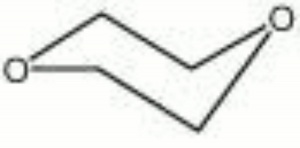Difference between revisions of "Dioxane"
Jump to navigation
Jump to search
| (One intermediate revision by one other user not shown) | |||
| Line 2: | Line 2: | ||
A toxic, colorless liquid with a slight ether-like smell. Dioxane is no longer recommended for use. In the past, it was used as a [[solvent]] for [[cellulose acetate]], [[ethyl cellulose]], [[benzyl cellulose]], and other resins, [[oil|oils]], and [[wax|waxes]]. It was often found in paint and varnish removers. Dioxane was also used as a [[surfactant]] and [[dispersant]] in textile processing, dyeing, and printing. | A toxic, colorless liquid with a slight ether-like smell. Dioxane is no longer recommended for use. In the past, it was used as a [[solvent]] for [[cellulose acetate]], [[ethyl cellulose]], [[benzyl cellulose]], and other resins, [[oil|oils]], and [[wax|waxes]]. It was often found in paint and varnish removers. Dioxane was also used as a [[surfactant]] and [[dispersant]] in textile processing, dyeing, and printing. | ||
| − | + | [[[SliderGallery rightalign|dioxane.jpg~Chemical structure]]] | |
== Synonyms and Related Terms == | == Synonyms and Related Terms == | ||
diethylene oxide; dioxyethylene ether; 1,4-diethylene dioxide; diethylene ether; 1,4-dioxane | diethylene oxide; dioxyethylene ether; 1,4-diethylene dioxide; diethylene ether; 1,4-dioxane | ||
| − | + | == Risks == | |
| − | == | + | * Highly toxic by skin contact, inhalation, and ingestion. |
| + | * Suspected carcinogen. | ||
| + | * Fumes are highly flammable and explosive. Flash point = 12C (54F) | ||
| + | * ThermoFisher: [https://www.fishersci.com/store/msds?partNumber=AC615121000&productDescription=1+4-DIOXANE+ANHYD&vendorId=VN00033901&countryCode=US&language=en SDS] | ||
| + | ==Physical and Chemical Properties== | ||
Miscible in water and most organic solvents. | Miscible in water and most organic solvents. | ||
| Line 22: | Line 26: | ||
|- | |- | ||
! scope="row"| Melting Point | ! scope="row"| Melting Point | ||
| − | | 11.8 | + | | 11.8 C |
|- | |- | ||
! scope="row"| Density | ! scope="row"| Density | ||
| − | | 1.0329 | + | | 1.0329 g/ml |
|- | |- | ||
! scope="row"| Molecular Weight | ! scope="row"| Molecular Weight | ||
| Line 34: | Line 38: | ||
|- | |- | ||
! scope="row"| Boiling Point | ! scope="row"| Boiling Point | ||
| − | | 101.1 | + | | 101.1 C |
|} | |} | ||
| − | == | + | ==Resources and Citations== |
| − | |||
| − | |||
| − | |||
| − | |||
| − | |||
| − | |||
* R. J. Gettens, G.L. Stout, ''Painting Materials, A Short Encyclopaedia'', Dover Publications, New York, 1966 | * R. J. Gettens, G.L. Stout, ''Painting Materials, A Short Encyclopaedia'', Dover Publications, New York, 1966 | ||
Latest revision as of 15:58, 21 July 2022
Description
A toxic, colorless liquid with a slight ether-like smell. Dioxane is no longer recommended for use. In the past, it was used as a Solvent for Cellulose acetate, Ethyl cellulose, Benzyl cellulose, and other resins, oils, and waxes. It was often found in paint and varnish removers. Dioxane was also used as a Surfactant and Dispersant in textile processing, dyeing, and printing.
Synonyms and Related Terms
diethylene oxide; dioxyethylene ether; 1,4-diethylene dioxide; diethylene ether; 1,4-dioxane
Risks
- Highly toxic by skin contact, inhalation, and ingestion.
- Suspected carcinogen.
- Fumes are highly flammable and explosive. Flash point = 12C (54F)
- ThermoFisher: SDS
Physical and Chemical Properties
Miscible in water and most organic solvents.
| Composition | C4H8O2 |
|---|---|
| CAS | 123-91-1 |
| Melting Point | 11.8 C |
| Density | 1.0329 g/ml |
| Molecular Weight | mol. wt. = 88.1 |
| Refractive Index | 1.420 |
| Boiling Point | 101.1 C |
Resources and Citations
- R. J. Gettens, G.L. Stout, Painting Materials, A Short Encyclopaedia, Dover Publications, New York, 1966
- Hermann Kuhn, Conservation and Restoration of Works of Art and Antiquities, Butterworths, London, 1986
- Michael McCann, Artist Beware, Watson-Guptill Publications, New York City, 1979
- The Merck Index, Martha Windholz (ed.), Merck Research Labs, Rahway NJ, 10th edition, 1983
- CRC Handbook of Chemistry and Physics, Robert Weast (ed.), CRC Press, Boca Raton, Florida, v. 61, 1980 Comment: ref. index = 1.420
